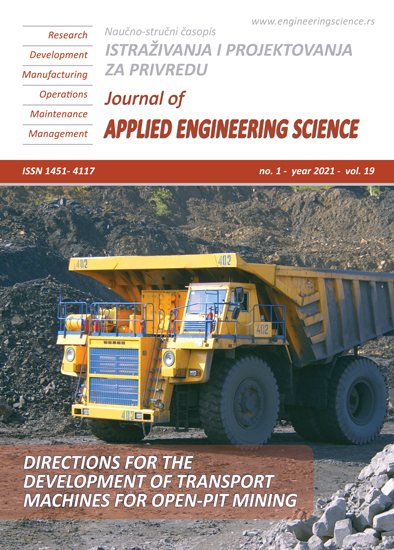STRUCTURE AND MECHANICAL PROPERTIES OF POWDERS OBTAINED BY ELECTRODISPERGING COBALT-CHROMIUM ALLOY
Abstract
The work presents the results of attestation of powders that were obtained from the KHMS "Cellite" alloy (Co - 63%, Cr - 27%, Mo - 5%, Ni - 2%, Fe - 2%) by electroerosive dispersion under various technological conditions (voltage from 100 V to 220 V, the capacitance of condenser from 15 μF to 50 μF, pulse frequency from 100 Hz to 200 Hz), and with using working fluids of different chemical composition and properties (water, kerosene, butyl alcohol). The study of the dispersion of the obtained powders, based on the results, established: the range of particle sizes is from 20 μm to 110 μm depending on the production modes. The results show various particle sizes, both a few nanometers and hundreds of microns. Depending on the technological modes of production, various mechanisms of the formation of powder particles can occur. Flake particles ranging in size from a few nanometers to (as a rule) one micron are obtained by the crystallization of the material vapor. They usually form agglomerates or stick to larger particles. Spherical and elliptical particles with a diameter from tens of nanometers to hundreds of microns were formed in crystallized material upon melting. The result of thermal and mechanical action during electroerosive dispersion was fragmentation grains with an average size from units to hundreds of microns. To meet the requirements for powders used in additive machines, it is necessary to select modes that exclude brittle destruction of the particles of the powder material and ensure the production of spherical or elliptical particles in the required particle size ranges. As a result of the experiment during the study of the phase composition of powders, using various technological modes and the composition of working fluids, the following phases were revealed: Cobalt (Co) with a cubic crystal lattice, a = b = c = 3.561079 Å; Chromium (Cr) with a hexagonal crystal lattice a = b = 2.738459 Å, c = 4.55078 Å; Nickel (Ni) with a hexagonal crystal lattice, a = b = 2.652590 Å, c = 4.380519 Å; sigma-Cr7Co3 (Cr7Co3 with a tetragonal crystal lattice, a = b = 8.656172 Å, c = 4.484030 Å; Cobalt Iron (CoFe), with a cubic crystal lattice, a = b = c = 2.846754 Å; Chromium Carbide (Cr3C2) with an orthorhombic crystal lattice: a = 2.821Å, b = 5.53Å and c = 11.47Å; Iron (Fe) with a cubic crystal lattice, a = b = c = 3.604293 Å; Cobalt Carbide (Co3C), with an orthorhombic crystal lattice, a = b = 4.455931 Å, c = 6.86598 Å; Cobalt Oxide (CoO) with a cubic crystal lattice a = b = c = 4.563279 Å; Magnetite (Fe3O4) with a cubic crystal lattice a = b = c = 8.4774342 Å.
References
Karlsson J., Snis A., Engqvist H., Lausmaa J. (2013) Characterization and comparison of materials produced by Electron Beam Melting (EBM) of two different Ti–6Al–4V powder fractions // Journal of Materials Processing Technology, vol. 213 (12), pp 2109–2118.
Safdar A., Wei L.Y., Snis A., Lai Z. (2012) Evaluation of microstructural developmentin electron beam melted Ti–6Al–4V // Materials Characterization, 2012, vol. 65, vol. 8–15.
Safdar A., He H.Z., Wei L.Y., Snis A. et al. (2012) Effect of process parameters settings and thickness on surface roughness of EBM produced Ti–6Al–4V // Rapid Prototyping Journal. vol. 18 (5). pp 401–408.
Loeber L., Biamino S., Ackelid U. et al. (2011) Comparison of Selective Laser and Electron Beam Melted Titanium Aluminides // Conference paper of 22nd International symposium “Solid freeform fabrication proceedings”, University of Texas, Austin. pp 547-556.
Biamino S., Penna A., Ackelid U. et al. (2011) Electron beam melting of Ti–48Al–2Cr–2Nb alloy: microstructure and mechanical properties investigation // Intermetallics, 2011, vol. 19, pp 776–781.
Song B., Dong S., Zhang B. et al. (2012) Effects of processing parameters on microstructure and mechanical property of selective laser melted Ti6Al4V. // Materials & Design, vol. 35. pp 120–125.
Song B., Dong S., Coddet P. et al. (2012) Fabrication and microstructure characterization of selective laser melted FeAl intermetallic parts // Surface and Coatings Technology, vol. 206. pp 4704–4709.
Wang Z., Guana K., Gaoa M. (2012) The microstructure and mechanical properties of deposited-IN718 by selective laser melting // Journal of Alloys and Compounds, vol. 513. pp 518–523
Latypov R.A., Ageev E.V., Altukhov A.Y., Ageeva E.V. (2018) Manufacture of cobalt–chromium powders by the electric discharge dispersion of wastes and their investigation // Russian metallurgy (Metally). vol. 2018. No. 12. pp 1177-1180.
Ageev E.V., Latypov R.A. (2014) Fabrication and investigation of carbide billets from powders prepared by electroerosive dispersion of tungsten-containing wastes // Russian Journal of Non-Ferrous Metals. vol. 55. No. 6. pp 577-580.

